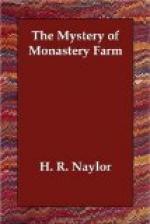Mr. Quintin was busy describing everything—and he knew all about everything: buildings, their uses and cost; the horses, as he stroked the nose of each—breed, age, peculiarities. Each cow and heifer he knew by name and age. The machinery—he was familiar with its make and use as well as its cost. If his eyes had been bandaged, apparently he could have described everything on Monastery Farm.
They next drove back to the farmhouse. It was a substantial brick building, containing twelve spacious rooms, furnished with plain, rather old-fashioned furniture, and set back from the river road about three hundred yards; it was surrounded by a well-kept lawn, and in all respects, the place was inviting and homelike.
“Mr. Sparrow,” said Quintin, “this farm contains two hundred and two acres of arable land, good land, no better, in fact, in the country. Besides, we have twenty acres of wooded land and a tenant house. This machinery is the best that we could find. We have two men—Giles and Ephraim; they are the best hands we know of, for Mr. Rixey trained them from their boyhood; there are no better. Mr. Rixey was our farmer twenty-six years. He died last November. Let us now have a look at the Monastery.”
Half a mile away they came to it, a large five-story brick building in the midst of native oak trees; a wide driveway led up to the front door, while in front was a sparkling fountain. Another, a smaller building, occupied a site near by, and constituted the president’s residence. The whole was inclosed with a tall iron fence.
Years before our story begins this land (three hundred acres) was donated by Richard Thorndyke, a wealthy Episcopalian, for a training school for clergymen, to which gift was added as an endowment fund one hundred thousand dollars on the condition that the church should erect suitable buildings. Thorndyke Theological Seminary was its original name; but, as the students as well as the teachers were all men, the people soon began to call it the Monastery, and in the course of years this became its common title; and the farm became known far and wide as Monastery Farm. This institution had from its inception found peculiar favor with the church as well as with the people, and the buildings were speedily erected. Two men at first were enough to do the teaching, as at the beginning there were only seventeen pupils, several of these students earning their tuition by working upon the farm. But at the time to which this story points one hundred and seventy-two students and nine professors composed the faculty besides the president, and the school was known as Monastery Classical and Theological College.
This inexperienced young Englishman as he saw all this became dismayed. This was too great an undertaking. He depreciated his own ability. This was altogether too big a job. He remembered that Nancy called it providential, but surely she was mistaken. What could he do with all that machinery? True, he had successfully managed his father’s one-hundred-acre farm, but this farm was twice as large. There were likewise oxen on the place, and he had never handled a yoke of oxen. No; he would take the night boat home. Surely something more suitable would turn up.




